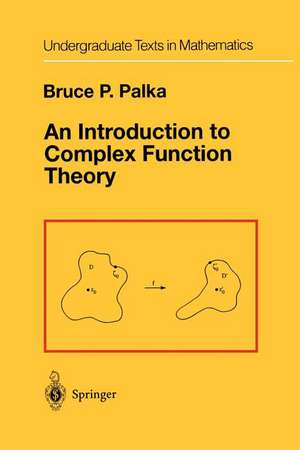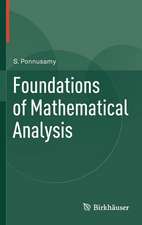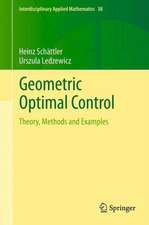An Introduction to Complex Function Theory: Undergraduate Texts in Mathematics
Autor Bruce P. Palkaen Limba Engleză Paperback – 30 sep 2012
Din seria Undergraduate Texts in Mathematics
- 17%
 Preț: 362.13 lei
Preț: 362.13 lei - 17%
 Preț: 365.43 lei
Preț: 365.43 lei -
 Preț: 332.02 lei
Preț: 332.02 lei -
 Preț: 440.01 lei
Preț: 440.01 lei -
 Preț: 351.54 lei
Preț: 351.54 lei - 13%
 Preț: 389.61 lei
Preț: 389.61 lei - 8%
 Preț: 384.89 lei
Preț: 384.89 lei -
 Preț: 290.80 lei
Preț: 290.80 lei -
 Preț: 400.43 lei
Preț: 400.43 lei -
 Preț: 449.62 lei
Preț: 449.62 lei -
 Preț: 402.35 lei
Preț: 402.35 lei -
 Preț: 372.27 lei
Preț: 372.27 lei - 17%
 Preț: 367.24 lei
Preț: 367.24 lei -
 Preț: 424.14 lei
Preț: 424.14 lei -
 Preț: 398.78 lei
Preț: 398.78 lei -
 Preț: 257.71 lei
Preț: 257.71 lei -
 Preț: 306.96 lei
Preț: 306.96 lei -
 Preț: 367.41 lei
Preț: 367.41 lei -
 Preț: 380.27 lei
Preț: 380.27 lei -
 Preț: 280.65 lei
Preț: 280.65 lei -
 Preț: 298.01 lei
Preț: 298.01 lei -
 Preț: 407.96 lei
Preț: 407.96 lei -
 Preț: 359.49 lei
Preț: 359.49 lei -
 Preț: 415.95 lei
Preț: 415.95 lei -
 Preț: 400.43 lei
Preț: 400.43 lei -
 Preț: 407.63 lei
Preț: 407.63 lei -
 Preț: 358.11 lei
Preț: 358.11 lei - 17%
 Preț: 368.61 lei
Preț: 368.61 lei -
 Preț: 370.78 lei
Preț: 370.78 lei -
 Preț: 395.09 lei
Preț: 395.09 lei -
 Preț: 364.41 lei
Preț: 364.41 lei -
 Preț: 339.37 lei
Preț: 339.37 lei -
 Preț: 304.91 lei
Preț: 304.91 lei -
 Preț: 433.85 lei
Preț: 433.85 lei - 15%
 Preț: 417.75 lei
Preț: 417.75 lei - 17%
 Preț: 362.67 lei
Preț: 362.67 lei - 20%
 Preț: 466.84 lei
Preț: 466.84 lei - 19%
 Preț: 400.52 lei
Preț: 400.52 lei - 17%
 Preț: 373.60 lei
Preț: 373.60 lei - 17%
 Preț: 395.93 lei
Preț: 395.93 lei -
 Preț: 329.95 lei
Preț: 329.95 lei - 19%
 Preț: 492.83 lei
Preț: 492.83 lei -
 Preț: 396.24 lei
Preț: 396.24 lei -
 Preț: 390.08 lei
Preț: 390.08 lei
Preț: 485.09 lei
Preț vechi: 570.70 lei
-15% Nou
Puncte Express: 728
Preț estimativ în valută:
92.83€ • 99.26$ • 77.39£
92.83€ • 99.26$ • 77.39£
Carte tipărită la comandă
Livrare economică 18 aprilie-02 mai
Preluare comenzi: 021 569.72.76
Specificații
ISBN-13: 9781461269670
ISBN-10: 1461269679
Pagini: 584
Ilustrații: XVII, 560 p.
Dimensiuni: 155 x 235 x 35 mm
Greutate: 0.81 kg
Ediția:Softcover reprint of the original 1st ed. 1991
Editura: Springer
Colecția Springer
Seria Undergraduate Texts in Mathematics
Locul publicării:New York, NY, United States
ISBN-10: 1461269679
Pagini: 584
Ilustrații: XVII, 560 p.
Dimensiuni: 155 x 235 x 35 mm
Greutate: 0.81 kg
Ediția:Softcover reprint of the original 1st ed. 1991
Editura: Springer
Colecția Springer
Seria Undergraduate Texts in Mathematics
Locul publicării:New York, NY, United States
Public țintă
Lower undergraduateCuprins
I The Complex Number System.- 1 The Algebra and Geometry of Complex Numbers.- 2 Exponentials and Logarithms of Complex Numbers.- 3 Functions of a Complex Variable.- 4 Exercises for Chapter I.- II The Rudiments of Plane Topology.- 1 Basic Notation and Terminology.- 2 Continuity and Limits of Functions.- 3 Connected Sets.- 4 Compact Sets.- 5 Exercises for Chapter II.- III Analytic Functions.- 1 Complex Derivatives.- 2 The Cauchy-Riemann Equations.- 3 Exponential and Trigonometric Functions.- 4 Branches of Inverse Functions.- 5 Differentiability in the Real Sense.- 6 Exercises for Chapter III.- IV Complex Integration.- 1 Paths in the Complex Plane.- 2 Integrals Along Paths.- 3 Rectiflable Paths.- 4 Exercises for Chapter IV.- V Cauchy’s Theorem and its Consequences.- 1 The Local Cauchy Theorem.- 2 Winding Numbers and the Local Cauchy Integral Formula.- 3 Consequences of the Local Cauchy Integral Formula.- 4 More About Logarithm and Power Functions.- 5 The Global Cauchy Theorems.- 6 SimplyConnected Domains.- 7 Homotopy and Winding Numbers.- 8 Exercises for Chapter V.- VI Harmonic Functions.- 1 Harmonic Functions.- 2 The Mean Value Property.- 3 The Dirichlet Problem for a Disk.- 4 Exercises for Chapter VI.- VII Sequences and Series of Analytic Functions.- 1 Sequences of Functions.- 2 Infinite Series.- 3 Sequences and Series of Analytic Functions.- 4 Normal Families.- 5 Exercises for Chapter VII.- VIII Isolated Singularities of Analytic Functions.- 1 Zeros of Analytic Functions.- 2 Isolated Singularities.- 3 The Residue Theorem and its Consequences.- 4 Function Theory on the Extended Plane.- 5 Exercises for Chapter VIII.- IX Conformal Mapping.- 1 Conformal Mappings.- 2 Möbius Transformations.- 3 Riemann’s Mapping Theorem.- 4 The Caratheodory-Osgood Theorem.- 5 Conformal Mappings onto Polygons.- 6 Exercises for Chapter IX.- X Constructing Analytic Functions.- 1 The Theorem of Mittag-Leffler.- 2 The Theorem of Weierstrass.- 3 Analytic Continuation.- 4 Exercises for ChapterX.- Appendix A Background on Fields.- 1 Fields.- 1.1 The Field Axioms.- 1.2 Subfields.- 1.3 Isomorphic Fields.- 2 Order in Fields.- 2.1 Ordered Fields.- 2.2 Complete Ordered Fields.- 2.3 Implications for Real Sequences.- Appendix B Winding Numbers Revisited.- 1 Technical Facts About Winding Numbers.- 1.1 The Geometric Interpretation.- 1.2 Winding Numbers and Jordan Curves.
















